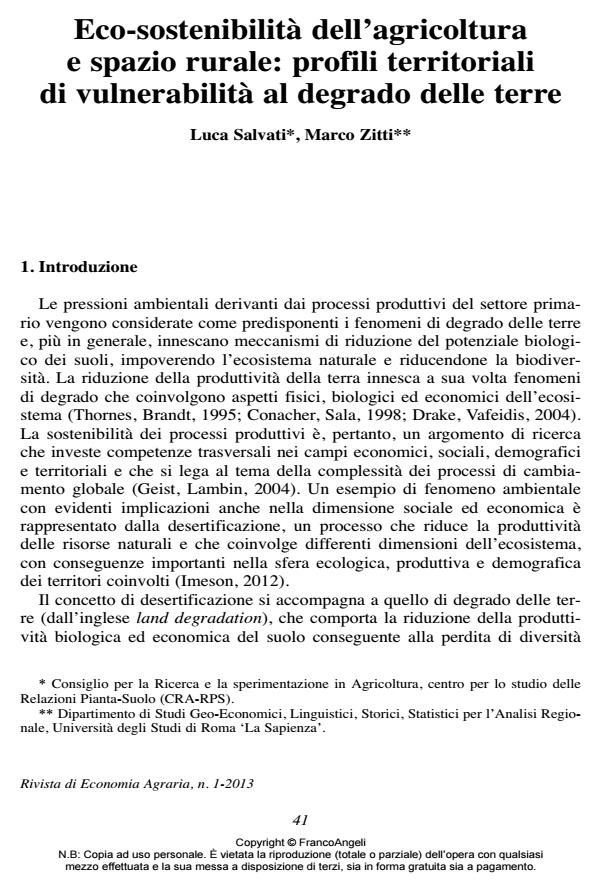Eco-sostenibilità dell’agricoltura e spazio rurale: profili territoriali di vulnerabilità al degrado delle terre
Titolo Rivista RIVISTA DI ECONOMIA AGRARIA
Autori/Curatori Luca Salvati, Marco Zitti
Anno di pubblicazione 2013 Fascicolo 2013/1
Lingua Italiano Numero pagine 20 P. 41-60 Dimensione file 652 KB
DOI 10.3280/REA2013-001003
Il DOI è il codice a barre della proprietà intellettuale: per saperne di più
clicca qui
Qui sotto puoi vedere in anteprima la prima pagina di questo articolo.
Se questo articolo ti interessa, lo puoi acquistare (e scaricare in formato pdf) seguendo le facili indicazioni per acquistare il download credit. Acquista Download Credits per scaricare questo Articolo in formato PDF

FrancoAngeli è membro della Publishers International Linking Association, Inc (PILA)associazione indipendente e non profit per facilitare (attraverso i servizi tecnologici implementati da CrossRef.org) l’accesso degli studiosi ai contenuti digitali nelle pubblicazioni professionali e scientifiche
Drought, land degradation, and desertification are global problems which involve different climatic, soil, vegetation, agricultural and demographic factors. Originally attributed to the most arid regions of the world, the risk of desertification has rapidly increased in temperate regions. In Mediterranean Europe, high human pressure, climatic changes, and intensive agriculture development has combined to produce land consumption, a key factor in starting desertification processes. Unfortunately, the effect of agriculture on land degradation has been poorly considered as far as quantitative indicators and cartographic tools are concerned. The aim of this paper is to introduce a system of agro-environmental indicators aimed at improving a model for desertification risk assessment, especially focusing on land quality, farm management and the impact of agricultural practices. Based on a multivariate exploratory strategy including non-hierarchical cluster analysis and linear discriminant analysis, thirty-two indicators have been included in an Environmentally Sensitive Area (ESA) application to define the contribution of agriculture to land sensitivity in the Region of Lazio (Latium), Italy. Finally, new findings achieved in the context of the agricultural impact on the environment have been discussed as an original contribution to the study of desertification.
Parole chiave:Analisi multivariata esplorativa, scala comunale, indicatori agro-ambientali, indici di vulnerabilità, desertificazione, Mediterraneo
Jel codes:Q010, Q240, Q300, Q570, R140
Luca Salvati, Marco Zitti, Eco-sostenibilità dell’agricoltura e spazio rurale: profili territoriali di vulnerabilità al degrado delle terre in "RIVISTA DI ECONOMIA AGRARIA" 1/2013, pp 41-60, DOI: 10.3280/REA2013-001003